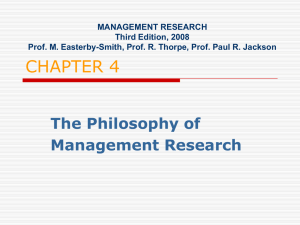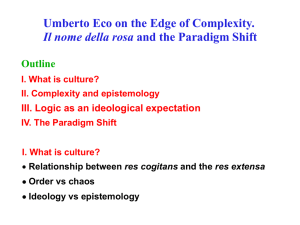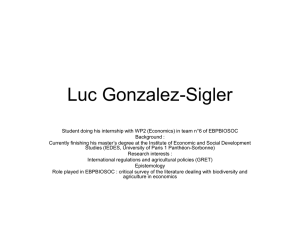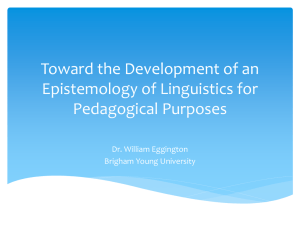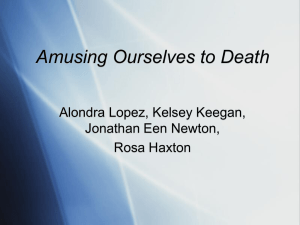The Simple and the Complex in E. C. Richardson`s Theory of
advertisement
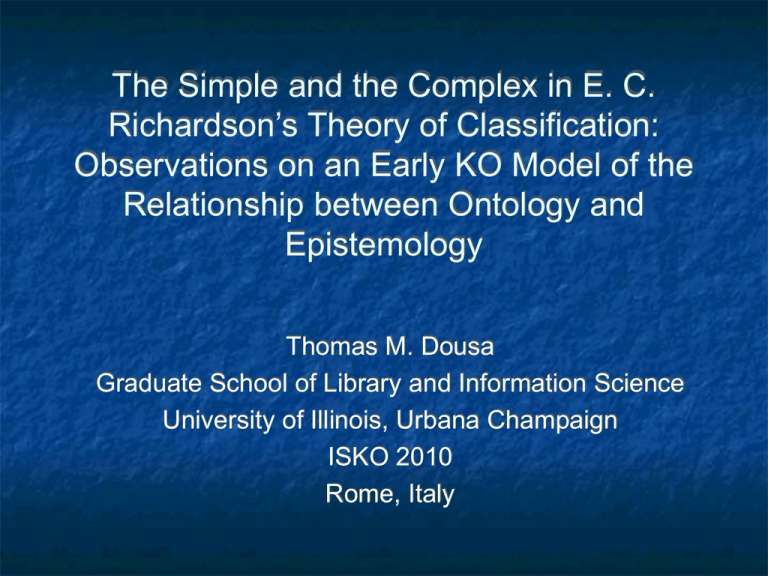
The Simple and the Complex in E. C. Richardson’s Theory of Classification: Observations on an Early KO Model of the Relationship between Ontology and Epistemology Thomas M. Dousa Graduate School of Library and Information Science University of Illinois, Urbana Champaign ISKO 2010 Rome, Italy Ontology, Epistemology and Classification in KO • Ontology: an account of what exists in the world. • Epistemology: an account of how human beings come to know what they know. • Both ontology and epistemology are necessary for classification design, but there are divergences of opinion over which should take precedence. • What are the ways in which ontology and epistemology interact within a single classification system? E. C. Richardson’s Theory of Classification: A Case Study in the Interaction of Ontology and Epistemology • E. C. Richardson (1860–1939): • American librarian and bibliographer • Author of Classification, theoretical and practical (1st ed. in 1901; further eds. In 1912 & 1930), the first major book on classification theory in (Anglo-American) L(I)S. • Richardson’s theory provides a historically influential early attempt at synthesizing ontology and epistemology in a single classification scheme. Richardson’s Evolutionary Classification: An Ontological Order from the Simple to the Complex (I) According to Richardson, • Bibliothecal classification was to be based on the order of sciences. • “The order of the sciences is simply the counterpart of the order of things” (Richardson 1901, p. 19). • In other words, theoretical classification is to follow an ontological order. Richardson’s Evolutionary Classification: An Ontological Order from the Simple to the Complex (II) • Like other intellectuals in late 19th and 20th century America and Europe, Richardson adopted a popular form of evolutionism positing development from simpler to more complex forms of being in all phases of existence (i. e. physical, biological, social). . Richardson’s Evolutionary Classification: An Ontological Order from the Simple to the Complex (III) • Richardson’s three laws of general classification: 1. “The law of likeness” 2. “The historical law” 3. “The law of evolution” * Evolutionary classification = “Classification according to the order of likeness from the simplest to the most complex” -- See Richardson 1901, pp. 15 & 11 Richardson’s Evolutionary Classification: An Ontological Order from the Simple to the Complex (IV) • Evolutionary order from “simple” to “complex” acc. to Richardson: Things: basic particles -> inanimate matter (“lifeless things”) -> plants and animals (“living things”) -> “human things” -> God (“supernatural things”) Sciences: “hylology” (physical sciences) -> “biology” -> “anthropology” (includes psychology and sociology) -> “Theology” -- Richardson 1901, pp. 29–44. Richardson’s Logical Classification: An Epistemological Order from the Complex to the Simple (I) • According to Richardson, Logical classification = “classification according to the degree of likeness from most complex to the simplest” (Richardson 1901, p. 11): it is thus an “inverse evolutionary order” (p. 72). Evolutionary classification and logical classification form two “‘faces of the ‘one natural order’” of the world” (p. 11). Richardson’s Logical Classification: An Epistemological Order from the Complex to the Simple (II) • According to Richardson, The inverse evolutionary order of logical classification “follows the order in which the human mind proceeds in tracing out the order of things [rather] than the natural order of things …” (Richardson 1901, pp. 72–73). Logical classification thus represents an epistemological order. Richardson’s Epistemology: Some Core Assumptions • Richardson’s epistemology is: * realist. It assumes that human concepts can truly correspond to things in the world. * representationist. It assumes that both the conceptual content and structure of a well-constructed classification constitute “an inner cosmos ‘mirroring’ the outer cosmos” (Richardson, p. 28). Richardson’s Epistemology in light of current KO discussions about epistemology • From the perspective of Hjørland’s (1997, 2008) typology of epistemological positions, Richardson’s epistemology is empiricist and positivist. • From another perspective, it can be viewed as a version of the naturalistic epistemology outlined by Gnoli (2004). Richardson and the Naturalistic Approach to Epistemology and Ontology: Convergences • Both understand human knowledge to be strongly constrained by, and so to reflect, the way the external world is. • Both posit classificatory orders based on an ontological order progressing from the simpler to the complex (“evolutionary classification” for Richardson; integrative levels for Gnoli). Richardson and Gnoli’s Naturalistic Approach to Epistemology and Ontology: Contrasts • Richardson’s and Gnoli’s epistemologies differ in their account of the tightness of fit between things in the world and human conceptualizations of those things: * Richardson’s epistemology offers a single, neutral, and universal account of human knowledge. * Gnoli’s epistemology, by contrast, acknowledges local cultural diversity within a deeper underlying cognitive unity (“hypothetical realism”). To Sum Up … • In positing an inverse relation between ontological and epistemological order, Richardson created a comprehensive theory of classification that, neatly and simply, harmonized ontology and epistemology. • However, the simplicity of Richardson’s solution came at the price of an oppressively “monistic” account of human knowledge. • More recent versions of naturalistic epistemology that make allowance for perspectivism (e.g., “viewpoint warrant” in Gnoli 2009) provide a more promising path to reconciling ontology and epistemology in a single comprehensive classification scheme. References • Gnoli C. (2004). Naturalism vs. pragmatism in knowledge organization. In I. C. McIlwaine (ed.), Knowledge organization and the global information society: Proceedings of the Eighth International ISKO Conference, 13–16 July, 2004, London, UK (pp. 263–268). Würzburg: Ergon. • Gnoli C., 2009, Animals belonging to the emperor: enabling viewpoint warrant in classification, in Proceedings of the IFLA satellite pre-conference of the classification and indexing section: “Looking at the past and preparing for the future, Florence, 20–21 August, 2009, <www.ifla2009satelliteflorence.it/meeting2 /program/assets/Gnoli.pdf>. • Hjørland B. (1997). Information seeking and subject representation: an activitytheoretical approach to information science, Greenwood Press, Westport, CT. • Hjørland B., 2008, What is knowledge organization (KO)? Knowledge Organization, 35(2/3): 86–101. • Richardson E. C. (1901). Classification: theoretical and practical, New York: Charles Scribner’s Sons.

